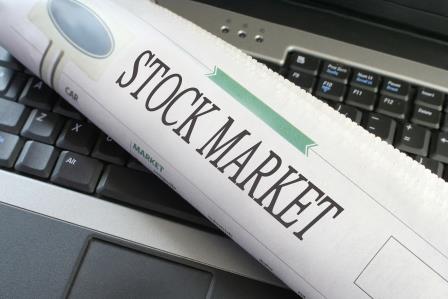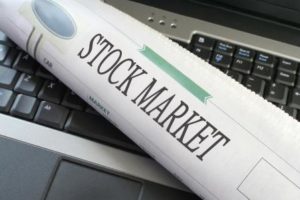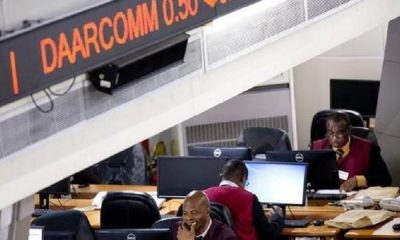Economy
2016 Recap and 2017 Market Outlook


By Ambrose Omordion
History has been made in the Nigeria capital market. For the third consecutive year, the benchmark All-Share Index of the Nigerian Stock Exchange (NSE) again contracted.
The 2016 contraction, unlike those of 2014 and 2015 was a single digit decline, fueling hope of a recovery soon.
The single digit contraction however resulted from the year-end seasonal trading volatility witnessed in the last few trading week of 2016, triggered by the low stock valuation and the agreement by members of the Organisation of Petroleum Exporting Countries (OPEC) to cut supply of crude oil to the international market as part of measures aimed at stabilizing oil prices.
The agreement was enhanced by the support of Russia, a major producer and non-member of the cartel, which also announced a cut in its production output. Market reaction to the news of the agreement which becomes effective this year, resulted in the gains by players in the NSE’s oil and gas sector as tracked via the Oil & Gas index.
The year 2016 was however rough for market players and analysts as unexpected events, negative economic data and company numbers continued to deepen to reflect the prevailing economic recession.
It is nonetheless obvious that during the year 2016, lack of concrete economic policies to give direction and the non-coordination of economic managers was also a major factor that affected domestic and international investor confidence in the market and the economy at large.
There was the impact of the delayed budget, coupled with the tight monetary policy regime adopted by the Central Bank of Nigeria (CBN).
The non-complementarity of fiscal and monetary policies was also evident, as both rather moved in opposite directions to the detriment of the masses, with the economy contracting in the first three quarters of the year as revealed by GDP numbers released by the National Bureau of Statistics (NBS).
The NBS on Saturday noted that if Nigeria must hold the unemployment rate at the current level of 13.9%, its economy must generate over 2.6 million annually, lamenting that the magnitude of employment in the country has not been sufficient to meet the ever-growing labour market, hence the continuous rise in the level of unemployment in the country.
The regulators of the market: SEC and NSE, recorded improvements despite the mixed general performance of the market for the year to close lower.
The development and growth of the nation capital market was highly driven by technology that continues to transform the face of the market and enhance transparency thereby restoring both domestic and international investors’ confidence in market activity.
Technology has also continued to make trading and investing simple with the online trading platforms that allows investors place trade from the comfort of their homes and offices, coupled with access to real market information that quicken investment decisions as more market operators creating online portals for their clients to trade directly on their own.
The composite index NSE ASI for the year shed 1765.68 points to close at 26,874.62 from an opening figure of 28,642.25 representing 6.16% decline after it had hit a high of 31,127.82 and low of 23,311.95 within the year under consideration.
The year started with a negative outlook in January which was characterized by the post-election fear of the leadership and economic management style of the new government, with share prices (especially of most blue-chips), volume and value recording new lows stocks, virtually all the indices crashed for that period.
They reversed up in February with oscillating movement that lasted five months, touching a high of 31,127.82points in June before pulling back to experience mixed performance of up and down movements, extending the periods of market bearishness that lasted for another five months (most notably from June to November) and these conditions made the latter part of the year quite interesting for many traders, before the end of the year rally reversed the bearish trend to close the month of December in green.
The Santa Claus rally effect was visible on the exchange.
The other leg of the market which is the primary market had low activity, compared with the previous years as all proposed Right Issues, public offers or initial public offers were postponed due to uncertainties and low confidence of investors in the market, despite all the efforts of market regulator to admit more companies to the exchange. One company was however admitted for listing at the alterative market sector during the year.
As the market repositions to play its role in the nation’s economic development, government must introduce policies that will attract small and medium companies to sources medium and long fund from the stock market.
The market’s sectoral indices showed that two out of the 11 indices closed the year positive. They are: which are NSE Premium index and NSE Banking Index with 6.98% and 2.17% respectively, while others were in red apparels.
The loss suffered by the market in 2016 was attributed to many factors including unstable global financial market resulting from low price of crude oil at the beginning of the year, sell down in china’s equity market, unexpected vote by Britons to leave the Eurozone and the unexpected victory of U.S president-elect Donald Trump.
Also on the local scene, there were the effects of high interest rate, hyperinflation, high unemployment and low national output that led to the ongoing recession that affected the general earning power of Nigerian that to no savings no investment. Liquidity was also a challenge, with its negative effect on the market, leaving the scene for foreign portfolio investors who tend to be unstable, moving in any direction as dictated by owners of the funds who combed in and out of the market.
The situation was not helped by the failure of the registered market makers to take off, as they are financially handicapped to play the role of stabilizing the system.
The regulators of the financial market need to come together to fashion ways that funds can flow into the market to ensure it performs its role in economic development and growth effectively.
Moreover, we would like to share our top trading themes in 2017 and where stocks, sectors, domestic and global economies are headed in the first quarter of 2017 and beyond.
In our INVEST 2017 SUMMIT held on December 3, 2016, top 10 recession proof stocks were discussed as only 18 stocks out of 219 listed companies that will grow their dividend for 2017 were recommended for investors and traders that participated at that event and these are companies with strong earnings capacity and support high pay-out ratios and high dividend yields with returns better than those of fixed income assets and cushion against the nation’s inflation rate, while the NSEASI posted a loss of 6.16 per cent in the same period. Other stocks can be traded with Technical Analysis using Support and Resistant trend line.
Over the past year the three stocks that recorded triple digits appreciation in price have recovered from 2015 down sell as a result of positive market sentiments and strong financials. Also, 13 equities recorded two digits capital growth for the same period to create value for investors.
In all, a total of 27 stocks, including the single digit gainers, were the best performing for the year.
The top five are Dangote Flour with 276.11% gain; United Capital, 108.4% capital appreciation; while Total Nigeria, Seplat and Mobil Oil recorded capital growth of 103.39%, 87.19% and 74.38% respectively. The domination of the top gainers’ table by petroleum stocks may likely continue in the New Year with other stocks that had performed well within the period.
On the flip side, over 55 stocks were among the worst performers for the year.
The top five are: Forte Oil that lost 74.42%; and Skye Bank, 68.35%; while Calverton, Diamond Bank and Sterling Bank were down by 63.56%, 61.74% and 58;47% respectively.
For profitable stock market investment and trading in the new year, get our INVEST 2017 TRADERS & INVESTORS SUMMIT home study pack for your guide in taking advantage of the next earnings season in 2017.
It is true that stocks are selling relatively at a low valuation now due to prolonged down market that was triggered by the exit of foreign investors in the market as result of falling oil prices and post-election uncertainties of the new government that created confidence crisis. But with the little improvement recorded in the Q3 GDP figures, despite still being negative, the contraction is reducing when you look at the change in Q1 GDP of -0.40, Q2 of -2.02 and Q3 of -2.24 which is a pointer that Q4 may likely be lower still to continue in a positive light especially as we expect the government to review and improve on its fiscal policies to boost productivity in the new year with the N7.3 trillion budget proposal for 2017.
Also it is expected that the CBN in the New Year should review its one-sided monetary policy in view of the need for greater collaboration in 2017 to save the nation from continued recession. The gradual return of foreign portfolio investors due to expected improvement in the nation’s reserve and implementation of the OPEC agreement in this first quarter of 2017. Also, it will boost government’s revenue and enhance implementation of the budget if passed earlier, given that the budget benchmark is $42.5 per barrel of oil, at a time it is already trading above $55.
In the New Year, investors should target stocks in the following industries: building material, construction, hospitality, energy, agriculture, financial and services that had suffered losses due to a bearish market that still has strong earnings power that can drive the price up again.
The global economy is likely to remain unstable, despite the expected increase in crude oil price in January as Britons prepare to exit the Eurozone and policy change in US by the new government which may likely redirect flow of funds.
Investors should be optimistic about the New Year as our comprehensive outlook for 2017 for publication next week and the outcome of the INVEST 2017 TRADERS & INVESTORS SUMMIT reveal a bullish signal for the year.
The chart below highlights the day change of the All Share Index for the entire year, with up days represented in green and down days in red. January march, May, June, July October, November and December were definitely the most volatile months of the year.
https://trwstockbrokers.wordpress.com/2017/01/02/2016-recap-and-2017-market-outlook/amp/
Economy
LCCI Raises Eyebrow Over N15.52trn Debt Servicing Plan in 2026 Budget

By Adedapo Adesanya
The Lagos Chamber of Commerce and Industry (LCCI) has noted that the N15.52 trillion allocation to debt servicing in the 2026 budget remains a significant fiscal burden.
LCCI Director-General, Mrs Chinyere Almona, said this on Tuesday in Lagos via a statement in reaction to the nation’s 2026 budget of N58.18 trillion, hinging the success of the 2026 budget on execution discipline, capital efficiency, and sustained support for productive sectors.
She noted that the budget was a timely shift from macroeconomic stabilisation to growth acceleration, reflecting growing confidence in the economy.
She lauded its emphasis on production-oriented spending, with capital expenditure of N26.08 trillion, representing 45 per cent of total outlays, and significantly outweighing non-debt recurrent expenditure of N15.25 trillion.
According to Mrs Almona, this composition supports infrastructure development, industrial expansion, and productivity growth.
However, she explained that the N15.52 trillion allocation to debt servicing underscored the need for stricter borrowing discipline, enhanced revenue efficiency, and expanded public-private partnerships to safeguard investments that promote growth.
She added that a further review of the 2026 budget revealed relatively optimistic macroeconomic assumptions that may pose fiscal risks.
“The oil price benchmark of $64.85 per barrel, although lower than the $75.00 benchmark in the 2025 budget, appears optimistic when compared with the 2025 average price of about $69.60 per barrel and current prices around $60 per barrel.
“This raises downside risks to oil revenue, especially since 35.6 per cent of the total projected revenue is expected to come from oil receipts.
“Similarly, the oil production benchmark of 1.84 million barrels per day is significantly higher than the current level of approximately 1.49 million barrels per day.
“Achieving this may be challenging without substantial improvements in security, infrastructure integrity, and sector investment,” she said.
Mrs Almona said the exchange rate assumption of N1,512 to the Dollar, compared with N1,500 in the 2025 budget and about N1,446 per Dollar at the end of November, suggests expectations of a mild depreciation.
She said while this may support Naira-denominated revenue, it also increases the cost of imports, debt servicing, and inflation management, with broader macroeconomic implications.
The LCCI DG added that the inflation projection of 16.5 per cent in 2026, up from 15.8 per cent in the 2025 budget and a current rate of about 14.45 per cent, appeared optimistic, particularly in a pre-election year.
She also expressed concern about Nigeria’s historically weak budget implementation capacity, likely to be further strained by the combined operation of multiple budget cycles within a single year.
Looking ahead, Mrs Almona identified agriculture and agro-processing, manufacturing, infrastructure, energy, and human capital development as key drivers of growth in 2026.
She said that unlocking these sectors would require decisive execution—scaling irrigation and agro-value chains, reducing power and logistics costs for manufacturers, and aligning education and skills development with private-sector needs.
The LCCI head stressed the need to resolve issues surrounding the Naira for crude, increase the supply of oil to local refineries to boost local refining capacity and conserve the substantial foreign exchange used for fuel imports.
“Overall, the 2026 Budget presents a credible opportunity for Nigeria to transition from recovery to expansion.
“Its success will depend less on the size of allocations and more on execution discipline, capital efficiency, and sustained support for productive sectors.
Economy
Customs Street Chalks up 0.12% on Santa Claus Rally

By Dipo Olowookere
The Nigerian Exchange (NGX) Limited witnessed Santa Claus rally on Wednesday after it closed higher by 0.12 per cent.
Strong demand for Nigerian stocks lifted the All-Share Index (ASI) by 185.70 points during the pre-Christmas trading session to 153,539.83 points from 153,354.13 points.
In the same vein, the market capitalisation expanded at midweek by N118 billion to N97.890 trillion from the preceding day’s N97.772 trillion.
Investor sentiment on Customs Street remained bullish after closing with 36 appreciating equities and 22 depreciating equities, indicating a positive market breadth index.
Guinness Nigeria chalked up 9.98 per cent to trade at N318.60, Austin Laz improved by 9.97 per cent to N3.20, International Breweries expanded by 9.85 per cent to N14.50, Transcorp Hotels rose by 9.83 per cent to N170.90, and Aluminium Extrusion grew by 9.73 per cent to N16.35.
On the flip side, Legend Internet lost 9.26 per cent to close at N4.90, AXA Mansard shrank by 7.14 per cent to N13.00, Jaiz Bank declined by 5.45 per cent to N4.51, MTN Nigeria weakened by 5.21 per cent to N504.00, and NEM Insurance crashed by 4.74 per cent to N24.10.
Yesterday, a total of 1.8 billion shares valued at N30.1 billion exchanged hands in 19,372 deals versus the 677.4 billion shares worth N20.8 billion traded in 27,589 deals in the previous session, implying a slump in the number of deals by 29.78 per cent, and a surge in the trading volume and value by 165.72 per cent and 44.71 per cent apiece.
Abbey Mortgage Bank was the most active equity for the day after it sold 1.1 billion units worth N7.1 billion, Sterling Holdings traded 127.1 million units valued at N895.9 million, Custodian Investment exchanged 115.0 million units for N4.5 billion, First Holdco transacted 40.9 million units valued at N2.2 billion, and Access Holdings traded 38.2 million units worth N783.3 million.
Economy
Yuletide: Rite Foods Reiterates Commitment to Quality, Innovation

By Adedapo Adesanya
Nigerian food and beverage company, Rite Foods Limited, has extended warm Yuletide greetings to Nigerians as families and communities worldwide come together to celebrate the Christmas season and usher in a new year filled with hope and renewed possibilities.
In a statement, Rite Foods encouraged consumers to savour these special occasions with its wide range of quality brands, including the 13 variants of Bigi Carbonated Soft Drinks, premium Bigi Table Water, Sosa Fruit Drink in its refreshing flavours, the Fearless Energy Drink, and its tasty sausage rolls — all produced in a world-class facility with modern technology and global best practices.
Speaking on the season, the Managing Director of Rite Foods Limited, Mr Seleem Adegunwa, said the company remains deeply committed to enriching the lives of consumers beyond refreshment. According to him, the Yuletide period underscores the values of generosity, unity, and gratitude, which resonate strongly with the company’s philosophy.
“Christmas is a season that reminds us of the importance of giving, togetherness, and gratitude. At Rite Foods, we are thankful for the continued trust of Nigerians in our brands. This season strengthens our resolve to consistently deliver quality products that bring joy to everyday moments while contributing positively to society,” Mr Adegunwa stated.
He noted that the company’s steady progress in brand acceptance, operational excellence, and responsible business practices reflects a culture of continuous improvement, innovation, and responsiveness to consumer needs. These efforts, he said, have further strengthened Rite Foods’ position as a proudly Nigerian brand with growing relevance and impact across the country.
Mr Adegunwa reaffirmed that Rite Foods will continue to invest in research and development, efficient production processes, and initiatives that support communities, while maintaining quality standards across its product portfolio.
“As the year comes to a close, Rite Foods Limited wishes Nigerians a joyful Christmas celebration and a prosperous New Year filled with peace, progress, and shared success.”
-

 Feature/OPED6 years ago
Feature/OPED6 years agoDavos was Different this year
-
Travel/Tourism9 years ago
Lagos Seals Western Lodge Hotel In Ikorodu
-

 Showbiz3 years ago
Showbiz3 years agoEstranged Lover Releases Videos of Empress Njamah Bathing
-

 Banking8 years ago
Banking8 years agoSort Codes of GTBank Branches in Nigeria
-

 Economy3 years ago
Economy3 years agoSubsidy Removal: CNG at N130 Per Litre Cheaper Than Petrol—IPMAN
-

 Banking3 years ago
Banking3 years agoFirst Bank Announces Planned Downtime
-

 Banking3 years ago
Banking3 years agoSort Codes of UBA Branches in Nigeria
-

 Sports3 years ago
Sports3 years agoHighest Paid Nigerian Footballer – How Much Do Nigerian Footballers Earn






















